In 1900, Sir Arthur Evans excavated the ancient city now known as Knossos, Crete, and further excavations continued onwards from there. The digs revealed an earlier non-Greek palace cultured civilization that pre-dated the Mycenaeans, which before then were thought to be the first civilized peoples to inhabit a part of the Aegean. Knossos’s peak was dated to be roughly between the years 2,200 BC and 1,450 BC, and the culture inhabiting the city was named Minoan, named so after king Minos, the first Cretan king, Greek lawmaker and judge of the underworld. Inhabiting the island from around 3,000 BC, Minoans came to culturally and physically dominate Crete, and this spread to influence the mainland Greeks then living in Europe, the Mycenaeans; in 1,450 BC, it’s apparent that the Mycenaeans came to take control over the city of Knossos, and so the first Greeks, and indeed a factual part of the Greek legends of the heroic age, and their origins were established.
The Minoans were the first civilization in Europe. At least, they were the first to set up a well sophisticated Bronze-Age culture by the establishment of trading towns along the island’s coast and growing them. What arose from these trade posts were cities all centred around palace centres. The most noteworthy of these palaces were Knossos, Mallia, Phaistos and Zakros.
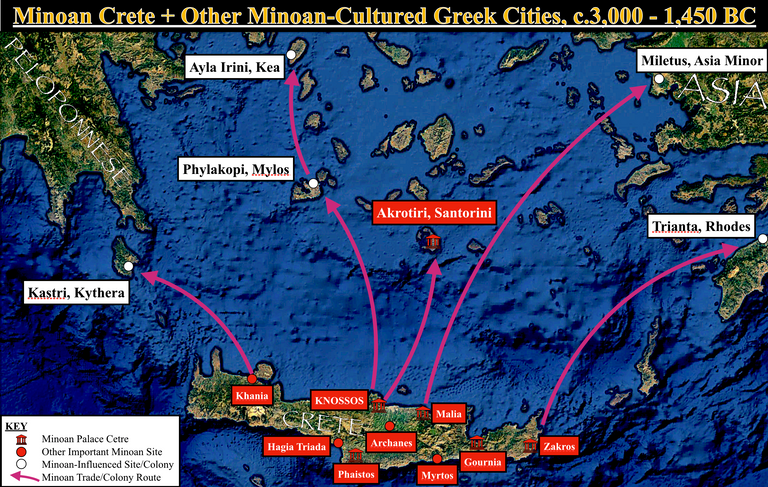
KNOSSOS
Situated nearby to Crete’s modern-day administrative capital city of Heraklion, Knossos was perhaps the most carefully arranged of the Minoan palace centres. Its decorated palace went on to birth the Minotaur (half human-bull) labyrinth legend. Paintings uncovered between the years 1900 and 1932 by British archaeologist Sir Arthur Evans showed vast amounts of images depicting bulls, double-faced axes and snakes, and it’s believed that this imagery played a vital role in Minoan religion and its customs. The imagery also reveals what looks like depicted Bull-Leaping, and it’s unclear whether this represented a religious act or simply a sport. Knossos was badly damaged in around 1,700 BC by a vicious earthquake, but the palace was soon reconstructed to a much larger scale. At around 18 hectares and containing several shrines within it, the palace did blossom and prosper for a roughly another 250 years. It seems apparent that the palace site lived through the destruction of other Minoan centres in around 1,450 BC, but it was later on taken over for a further two hundred years, likely by the Mycenaeans to the north.
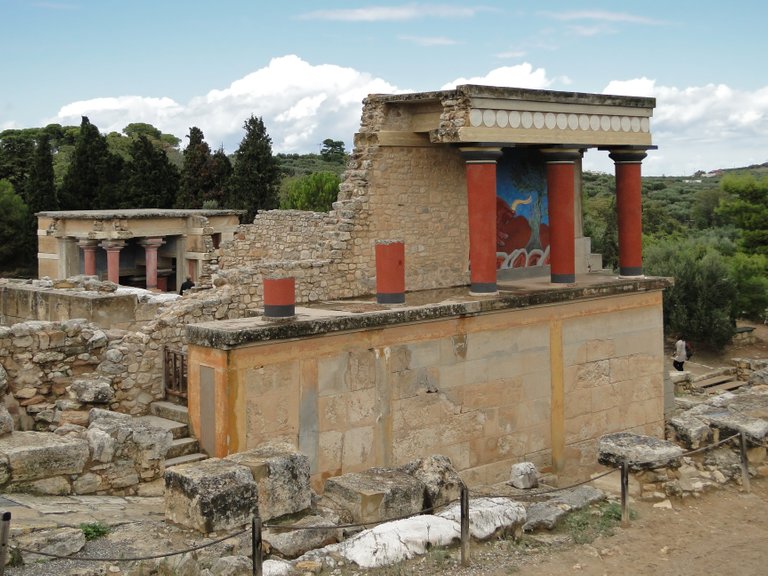
(Palace ruins of Knossos, Crete)
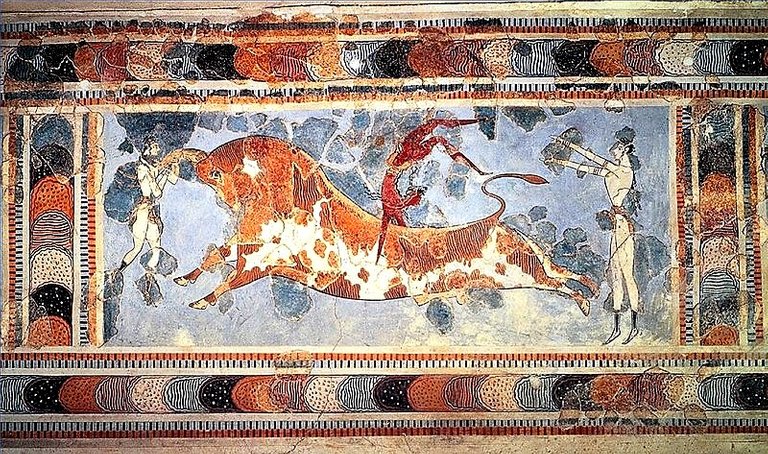
(Fresco of Bull Leaping, Knossos, either a religious ritual or a pass-time sport)
KINGS + LEADERS
The rulers of these Minoan cities played both political and religious roles when in power, and it’s likely that several other political figures in office were also priests serving the kings. While we are unable to decipher them today as they were written in Linear A, the kings did keep official archives. Under the kings, society was split up into four separate classes; the courts were held up by an agriculturally labouring class, and craftsmen made black, red and white pottery and other goods, such as “Kamáres ware” pots.
TRADE + COLONIES
The Minoans were highly dependent on their Mediterranean trade routes, becoming highly skilled for their day on the seas. As a result of this, they built up large fleets capable of ferrying themselves and their goods across the sea. The palace of Mallia, for example, was a key Minoan trade centre. Its excavations revealed that it was defended by a large town wall, unlike other Cretan cities of the time like Knossos and Phaistos.
Minoan trade routes were established at Miletus in Asia Minor, Trianta on the isle of Rhodes, Kastri on the isle of Kythera, Phylakopi on the isle of Mylos, and at Ayla Irini on the isle of Kea. These were sites of Minoan cultural influence, and possibly a Minoan colony. A Minoan palace was also established on the isle of Santorini.
LANGUAGE
The other earliest inhabitants of the Greek world were those who spoke in the assumed-to-exist language known simply as Proto-Greek. Amongst the Minoans, these peoples were the Helladics (situated in Boeotia, Euboea and the eastern Peloponnese), and Cycladics (centred around the Cyclades Islands of South-East Greece), and while, again, little is known about them as a whole, it’s generally agreed that their cultures came to an end as the Mycenaeans came to dominate much of the Aegean world.
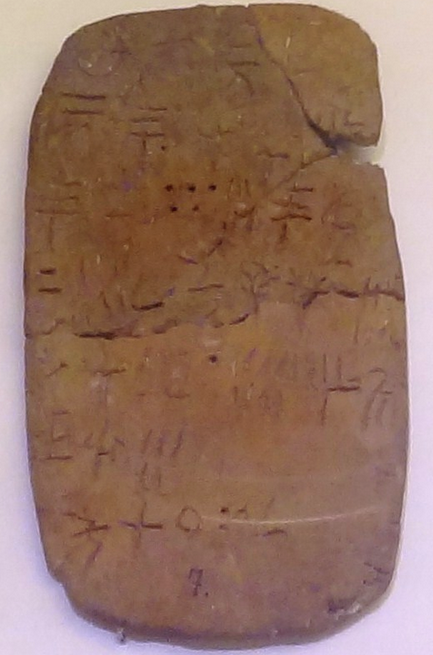
(Linear A Minoan clay tablet. Linear A remains undeciphered)
Early Greek inscriptions were functional. At the time of the Bronze Age, inscriptions contained signs, representing either a word or an idea, and as a result, thousands of individual signs were required.
• Logographic scripts - words
• Ideographic scripts - ideas
The earliest Greek writing was written from right to left. Words were not physically split up when written down, and the Greeks at this time were known to write down on to pottery. On pots, they were known to detail who the specific pot was made for and who it was made by.
While at this point it was known by archaeologists that the Minoans were not Greek, it was unknown who the Mycenaeans were exactly. However, Michael Ventris, an architect from England, translated some tablets that had been found at Pylos (Messenia, Southern Peloponnese) and Knossos, detailing the destruction levels of both the mainland city and the Cretan city in 1952. The Minoans wrote in a script known as Linear A, which remains undeciphered to this day, and it went on to develop the syllabic script we today know as Linear B, which the Mycenaeans wrote in.

(Linear A inscriptions from a Minoan pot)
THE HELLADICS
The Helladic culture of mainland Greece in the eastern Peloponnese consisted of a widespread farming pattern of settlements founded on low-lying hill lands, particularly by the sea, where trade routes and communications with outsiders would have been established. The Helladics in the Peloponnese occupied an area we would later call Lakonia, the eventual homeland of the Spartans. and surface surveying of the area has revealed between thirty and forty settlements in the Early Helladic age, mostly along the south coast and the Eurotas River. Most of these finds were solely linked to the finding of pottery shards, but it’s still clear that a culture occupied the area at the time, and the amount found in the area suggests the time period was a mainly prosperous and peaceful one for its time. Aside from the fragments of pottery found, two animal figurines have been found fragmented, one near Vapheio within the Spartan Basin, and one at Laina nearby to Goritsa. A golden horde, also containing silver jewellery, was dated to roughly 2,000 BC, in the Early Helladic era.
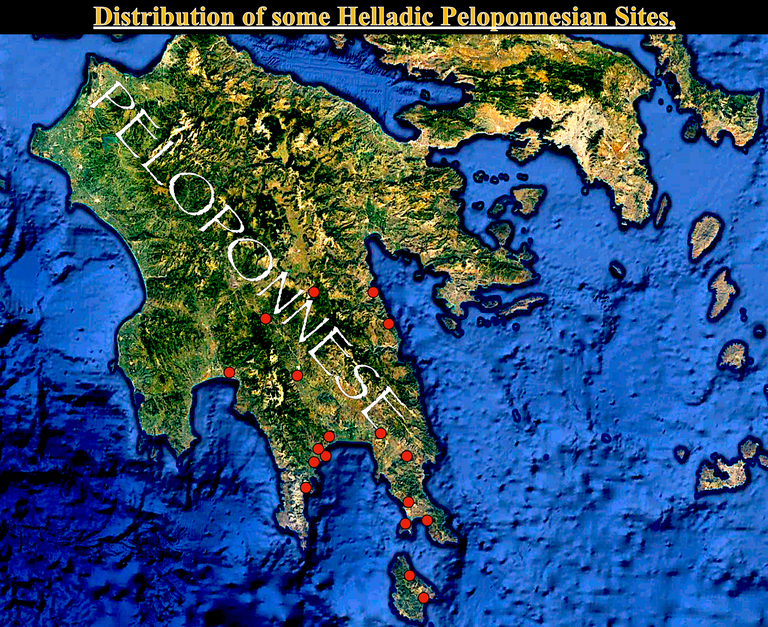
COLLAPSE OF MINOAN CRETE
The reasons for the gradual collapse of the Minoan culture is still not entirely clear, as is often the case with ancient history. However, around 1,500 BC, a large volcano erupted from the island of Thera. While the eruption itself may not have directly ended Minoan culture on Crete, it would have heavily affected their trade routes, undermining one of their main sources of wealth. Possibly around 50 years later, in c.1,450 BC, it’s believed that the Mycenaeans of mainland Greece invaded the isle of Crete, finishing off the already-weakened Minoan cities.
SOURCES:
• World History, Eyewitness Companions, by Philip Parker, pages 100-101
• Early Greece, Second Edition, by Oswyn Murray, pages 5-6
• Sparta and Lakonia: A Regional History 1300 - 362 BC, by Paul Cartledge, pages 26-31
• Texts, Readers and Writers Lectures, The University of Reading, by Professor Eleanor Dickey + Dr. Christa Gray
(All images used are copyright-free.)
Bettany Hughes on the Minoans (I DO NOT own this video)
Congratulations @oo7harv! You have completed the following achievement on the Steem blockchain and have been rewarded with new badge(s) :
You can view your badges on your Steem Board and compare to others on the Steem Ranking
If you no longer want to receive notifications, reply to this comment with the word
STOPTo support your work, I also upvoted your post!
Vote for @Steemitboard as a witness to get one more award and increased upvotes!